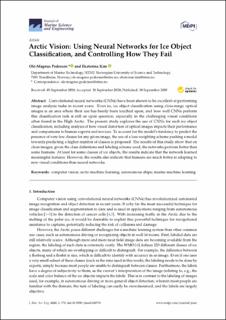Arctic Vision: Using Neural Networks for Ice Object Classification, and Controlling How They Fail
Peer reviewed, Journal article
Published version

Åpne
Permanent lenke
https://hdl.handle.net/11250/2683494Utgivelsesdato
2020Metadata
Vis full innførselSamlinger
- Institutt for marin teknikk [3429]
- Publikasjoner fra CRIStin - NTNU [37994]
Originalversjon
10.3390/jmse8100770Sammendrag
Convolutional neural networks (CNNs) have been shown to be excellent at performing image analysis tasks in recent years. Even so, ice object classification using close-range optical images is an area where their use has barely been touched upon, and how well CNNs perform this classification task is still an open question, especially in the challenging visual conditions often found in the High Arctic. The present study explores the use of CNNs for such ice object classification, including analysis of how visual distortion of optical images impacts their performance and comparisons to human experts and novices. To account for the model’s tendency to predict the presence of very few classes for any given image, the use of a loss-weighting scheme pushing a model towards predicting a higher number of classes is proposed. The results of this study show that on clean images, given the class definitions and labeling scheme used, the networks perform better than some humans. At least for some classes of ice objects, the results indicate that the network learned meaningful features. However, the results also indicate that humans are much better at adapting to new visual conditions than neural networks.
